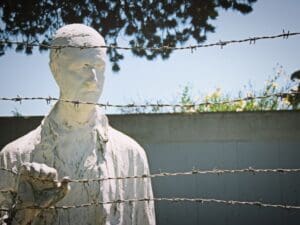One of the famous twentieth century French ‘Modern Art’ masters of Jewish-Belarusian origin, Marc Chagall (July 1887-March 1985), employed primary and secondary colors with different techniques to come out with a unique painting. He would use various shapes and symbols to gather the attention of the viewers for a detailed analysis. One of the most famous paintings of Marc Chagall is “I and the Village,” painted in Paris in 1911.
Marc Chagall’s most famous painting “I and the Village” seems like relating a small fairy tale in a rural area, his native village precisely. This oil on canvass painting, measuring 192.1 cm × 151.4 cm (75 in × 59 in), portrays the artist’s memories of Hasidic Community, a native community present outside Vitebsk. This painting is inspired by Marc’s Jewish life and his Russian childhood. Reflecting his emotions well, “I and the Village” is truly non-imitable and can be described in many beautiful words. At first, this remarkable painting perplexes its viewers, owing to its superimposed images. Upon analysis however, it unfolds as a beautiful horizon of fantasy.
Marc Chagall’s most famous painting “I and the Village” interestingly describes about the nature and its importance to human beings. Through different symbols and graphics, Chagall showed the give and take relationship of humans with the nature. He has depicted the mutual interdependence of humans, peasants here, animals, and plants on each other. In the foreground, a green-faced man, wearing a cap and holding a tree in his dark hands, can be seen staring at a goat, with its cheeks depicting the image of a smaller goat being milked. The background shows a violinist woman and two houses on the top, placed inverted, as Chagall did not give any importance to logical sequence. There is a series of houses, next to an Orthodox church. In the front of the violinist woman, a man, wearing black clothes with a scythe in hand, is shown.
Marc has also used a variety of large and small circular forms to show the sun’s revolution in the orbit, earth’s revolution around the sun, and moon’s revolution around the earth. Marc Chagall’s most famous painting “I and the Village” depicts an eclipse in which moon is situated at the lower left. The noticeable tree in the middle of the painting, balance it out to impart symmetry. The geometrical structures, such as lines, angles, triangles, circles, and squares used in “I and the Village” are inspired from ‘Cubism,’ the art of urban avant-garde society. Chagall’s paintings covered a particular geometric frame. Similarly, “I and the Village” is a scene of a particular area of the village, covered in a particular imaginary frame.
Considered a gem in the world of creativity, “I and the Village” of Marc Chagall is valued high. It presently graces the Museum of Modern Art, New York. Integrating Eastern European folk culture, both, Russian and Yiddish, this masterpiece is a smart star on the lines of creative fantasy. Truly, Marc Chagall was a marvelous painter, who could put all his emotions and qualities in the form of art.
Disclaimer: The views and opinions expressed in this article are those of the authors and do not necessarily reflect the official policy or position of Irish Artmart.



